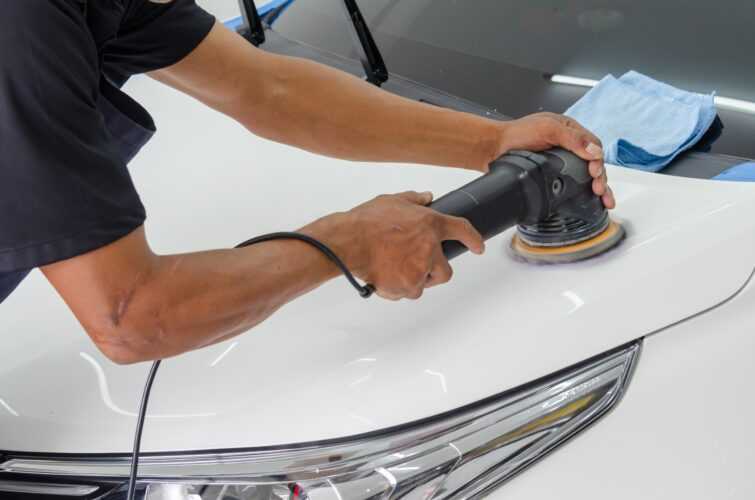Machine versus Hand Polishing: What You Need to Know

Getting your car polished is something a lot of motorists feel they need to leave to a professional detailer. Sure, it will come back from the body shop looking like it has just rolled out the showroom again. But a full pro detail and valet is far from cheap.
Besides, a lot of keen car enthusiasts like to feel they can look after their beloved vehicle by themselves. There’s a lot of pride to be taken (and money to be saved) in doing a job like polishing DIY – so long as the results are up to scratch.
Which begs the question – how do professional detailers give your car’s paintwork such a pristine finish? Is it something you can replicate at home?
The answer is yes – if you know what you are doing and are prepared to invest in the right car polishing equipment. One of the key secrets to a pro detailer’s trade is the use of polishing machines. But this in itself opens up a whole new debate – are polishing machines really suitable for the DIY car enthusiast, or are you better off sticking to the good old fashioned way, polishing by hand?
There are pros and cons to both approaches if you want to polish your car at home. Let’s take a look at both in turn.
Machine Polishing
There has been huge growth in recent years in the number of polishing machines designed for the DIY market. Two innovations in particular have been critical – the arrival of cordless, battery-operated polishing machines, which make things much more convenient and flexible for the home user, and, even more importantly, the development of dual action polishing machines.
Unlike standard rotary polishers, which spin in a single circular direction only, dual action polishers also pivot around a second axle, ‘wobbling’ the polishing disk as it spins. This serves to reduce the amount of friction between the polishing pad and the paintwork, helping inexperienced users avoid mistakes.
The obvious plus of using a polishing machine is that it makes the work much faster, much less labour intensive and, if you get it right, you can achieve a much higher level of polish than is possible by hand. Machines are also much better for restoring particularly worn out or marked paintwork.
The rub is the ‘getting it right’ part. Use the wrong cut of polishing pad or polish, set the rotation speed at too high a level, or simply leave the spinning disk in one place for too long, and you can easily ‘burn’ your paintwork – cutting through the top layers and marking the deeper coats, or in other words doing more damage than good. Dual action polishers help to lower the risk of this happening, but they don’t take it away completely.
Another potential drawback of buying a polishing machine is cost. The machines themselves cost several hundred pounds, and then you have ongoing expenses like pads and backing plates to add to polish itself. This is a worthwhile investment if you religiously take your vehicle to a professional detailer once a year, or if you are a committed hobbyist. But if you reckon on only giving your car a polish once in a blue moon or just want to fix a particular mark that has occurred, it’s a big outlay.
Hand polishing
In stark contrast to machine polishing, to hand polish your car you only really need two things – cutting compound / polish and something to apply it with. Ok, in reality you will probably need two or three grades of compound and polish to achieve a top notch finish, plus a clay bar to remove embedded debris before you start and wax to finish things off. But the main point still stands – hand polishing is comparatively cheap and straightforward.
There is also a much lower risk of over-polishing and damaging your paintwork. You would have to use a very heavily abrasive cutting compound and rub very, very hard to do lasting damage. But this benefit is also a weakness of hand polishing. Because you are relying on elbow grease alone, hand polishing is much less likely to remedy really obvious, deep marks in your paintwork, or give dull, ageing paintwork an as-new gleam.
Polishing by hand, it’s hard to create the amount of friction required to cut deep enough into the paintwork to smooth the most visible scratches, or to buff things up to a mirror-like finish. In fact, polishing by hand is just plain hard work. Your car has a surprisingly large surface area once you start trying to polish it by hand, and you have to really put your back into it – including repeating the process several times over with gradually finer cuts of polish – to achieve pleasing results.
In summary, if you are determined to keep your vehicle in pristine condition by sticking closely to a regular polishing regime, or if you have a bodywork project you want to restore to former glories, a machine may be a good investment. It can save you a lot of time and effort, not to mention money spent on professional detailing. But bear in mind there is a learning curve to using polishing machines effectively to achieve the best results, and there is always the risk of doing more damage than good to your paintwork.
If, on the other hand, your vehicle’s paintwork is in reasonably good condition and you simply want to give it the occasional spruce up, you may find hand polishing, for all the effort it takes, represents a safer, cheaper option.
Read more on
Have you checked us out on Instagram.
Check us out here.Related Stories
Advertisement Advertisement
Advertisement Advertisement
Advertisement

